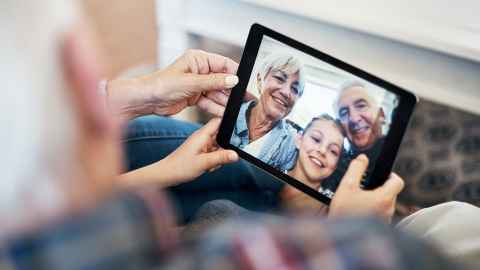A call for manaakitanga in a time of isolation
26 March 2020
Opinion: There's a distinction between social isolation and loneliness writes professor of gerontology, Vanessa Burholt. The key is to create intergenerational connections during this time of physical isolation.

Robust evidence shows that loneliness and social isolation can have an impact on mortality.
The risk is comparable to smoking, inactivity and air pollution. It’s been reported that a lack of social connection heightens the risk of mortality as much as smoking 15 cigarettes a day, and that loneliness and social isolation are twice as harmful to physical and mental health as obesity. Consequently, some of the fears about the impact of physical distancing and lockdown, as a result of the Covid-19 pandemic, have concentrated on isolation and loneliness and the potential negative consequences for older people.
If we’re looking to overcome the negative impact that restrictions to social contact may have on the most vulnerable – older people, but also adults and younger people with chronic conditions or compromised immune systems – we should focus on increasing solidarity between generations. This requires finding creative ways to connect while remaining in our homes and physically distant, as opposed to socially isolated.
There’s a distinction between social isolation (objectively reduced contact with others) and loneliness (the subjective emotional response to insufficient relationships to match one’s expectations), and each may require different responses. Reduced contact (isolation) can be met with practical solutions and purposeful actions which should ensure that marginalised and isolated older people are not left without essential services and goods such as groceries and medicine. We should all be mindful of the needs of people with reduced mobility or cognitive impairment, and their families and carers who may need help, especially if they are affected by the temporary loss of key support people. We also need to identify older people who may not have friends and family on whom to draw for help and kindness.
Older people may help younger people with homework or read stories over Skype or Zoom, while younger people may write emails, or use video calls to connect to older relatives, neighbours or residents in care homes.
There are good examples of ways to increase remote social contact emerging from Europe and the US. Europe-AGE, the Flemish Older Persons Council and the Gerontological Society of America have been highlighting inspirational practices. For example, some organisations are sending letters to older people in their communities, organising virtual meetings, and engaging in daily telephone chats. And prior to the lockdown, organisations had been providing meals to older people through home delivery.
Many voluntary organisations rely on older volunteers to deliver services, and research has indicated that volunteering has many benefits for quality of life and well-being. Older people who are having to stay home may consider volunteering for the first time, albeit in a different way. For example, in the US, Generations United suggests that older adults can provide support to young people in crisis through a ‘crisis text line’.
With schools around the world closing to reduce the community spread of Covid-19, there are opportunities for intergenerational solidarity through technology. For example, older people may help younger people with homework or read stories over Skype or Zoom, while younger people may write emails, or use video calls to connect to older relatives, neighbours or residents in care homes. Unfortunately, these practices will highlight any deficiencies in the infrastructure and the digital divide between those with or without the knowledge to use and maintain IT, and with/without financial means to purchase devices or data. My own new research points to older technologies, such as the telephone, being more effective than new technologies in reducing isolation in older people. (My article about technology-mediated communication will soon appear in The Gerontologist.)
Many retirement homes closed their doors to visitors to reduce the chance of community spread of Covid-19 even before the lockdown. But staff have devised novel methods of maintaining social links. Many have purchased iPads or tablets to make it easier for residents to chat with and see relatives. In some facilities, meals are no longer eaten communally, but handwritten notes are provided to residents with their delivered meals.

Moving on to consider the emotional effects of minimal social contact during the pandemic, it is worth noting that globally 2-16 percent of older people are lonely at any one time. While people are physically distancing themselves, their normal expectations for social engagement may not be met. Avoiding loneliness entails addressing any mismatch between the social contact a person has and what they want, by adjusting either the quality and frequency of social interaction (limited under these circumstances) or expectations regarding the quality and frequency of social interaction.
On the whole, people are good at adjusting their expectations to cope with negative life events, and psychologically adapt to changes in circumstances. This is called a 'satisfaction paradox' where objectively negative factors in one’s life (e.g. isolation) have relatively little effect on subjective quality of life (e.g. loneliness). Consequently, temporary isolation may have a limited impact on loneliness but longer periods of isolation can be difficult to adjust to and will increase loneliness. This means that some older people may have been experiencing loneliness before distancing measures were even adopted.
My collaborative research suggests that adjusting expectations about social contact may be particularly difficult for older people with cognitive impairment or depression. In these cases, older people may experience more loneliness than others and require additional emotional support.
The proliferation of headlines about ‘the elderly’ in relation to Covid-19 is overwhelming. As a social gerontologist, I have spent the past 20-plus years trying to explain that using chronological age to define a social group is problematic.
Vulnerability to Covid-19 may be due to social, financial and biological circumstances not just age. Specific underlying health conditions increase the risk of mortality, but these conditions are present in younger and older populations too. The term ‘the elderly’ homogenises a diverse population comprising two or three generations, as well as an array of cultures and socio-economic circumstances. As well, the term is commonly associated with negative and patronising stereotypes.
There is likely to be a longer-term impact associated with the legitimisation of ageism during this pandemic. Implementing alternative ways of connecting throughout this crisis may promote new forms of intergenerational solidarity beyond this uncertain time. Connections are more likely to decrease loneliness for older people in the long run, if meaningful and lasting relationships are developed and sustained.
It is manaaki – the kindness and support that we give to each other – that will help us get through this.
Vanessa Burholt is Professor in Gerontology in the School of Nursing and School of Population Health, Faculty of Medical and Health Sciences.
The views in this article reflect personal opinion and are not necessarily those of the University.
This piece was written for UniNews April. Editor, Denise Montgomery: denise.montgomery@auckland.ac.nz